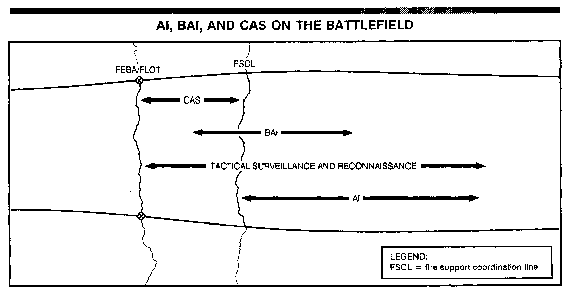



The force application role accomplished by attack air forces includes three missions differentiated by the intended goal of the mission. If the objective in striking a target is to destroy or neutralize the enemy's ability to produce or sustain military forces or his will to use those forces, the mission is a strategic attack. If the purpose of force application is to destroy, delay, or disrupt existing enemy surface forces while they are far enough from friendly surface forces that detailed coordination of aerospace and surface activities is not needed, the operation is an interdiction mission. If force is applied in support of offensive or defensive surface operations against enemy forces whose proximity to friendly surface forces is such that detailed coordination is needed, the operation is a close-air-support mission.
Strategic attack capabilities embody the essence of independent air power: the ability to strike directly at the will and warmaking capacity of the enemy unencumbered by surface military operations. Strategic attacks often comprise the most direct means available to force an enemy to cease fighting or to otherwise make decisions or concessions in line with friendly objectives. Since strategic strikes are theoretically unstoppable, their intended result--the capitulation of the enemy--has been viewed by some as inevitable. The reality has proven to be somewhat more complex. Technology has made possible aerial bombardment of strategic targets across the globe, but historical results have rarely fulfilled early theoretical assertions. It has often been proposed, for example, that aerospace power can "win" a war by itself, but strategic attacks cannot be guaranteed to directly compel a desired enemy response. Air interdiction is defined as air operations conducted to destroy, neutralize, or delay the enemy's potential before it can be brought to bear effectively against friendly forces and at such a distance from friendly ground forces that detailed coordination is not required. Typical AI targets might include enemy surface forces in the follow-on echelons, road and rail networks, C3 nodes, and supply depots. Battlefield Air Interdiction [BAI] is an Air Force task within the framework of the AI mission. The AI attacks conducted against hostile land forces that are not in close proximity to friendly forces are referred to as battlefield air interdiction if the hostile forces could have a near-term effect on the operation support or scheme of maneuver of friendly forces. Prior coordination is required between the Army and the Air Force for attack of BAI targets. BAI has a direct or near-term effect on surface operations. Close Air Support [CAS] is air action in operations against hostile targets of ground that are in close proximity to friendly forces and that require detailed integration of each air mission with the fire and movement of these forces. Close proximity means that friendly forces and/or noncombatants are close enough to the target that care must be taken to avoid casualties from air-delivered weapons effects.

The air control role accomplished by attack air forces includes Suppression of Enemy Air Defense [SEAD] and offensive counterair [OCA] missions.
Suppression of Enemy Air Defense [SEAD] is that activity which neutralizes, destroys, or temporarily degrades enemy air defense systems in a specific area to enable air operations to be successfully completed. SEAD is critical for all operations. CAS, BAI, and attack operations in support of combat operations require SEAD fires against the many antiaircraft systems that accompany the threat's forward elements. Some of this SEAD is appropriate for nonlethal (EW) attack assets that jam air defense radar systems. A critical element in performing SEAD is locating enemy air defense weapons and facilities. Electronic warfare support measures and other target acquisition sources are used for this purpose. Airspace coordination areas and phase lines may be used to coordinate a SEAD effort.The joint force commander decides on the objectives and priorities for the employment of air assets. The land component commander and the air component commander negotiate on a recommended apportionment of air assets to meet the various requirements anticipated. This process results in an apportionment recommendation, usually around 72 hours before active execution. The Air Tasking Order [ATO] is the means for implementing air opeations. It tasks assigned and attached fighter wings to do specific missions and gives enough detail that mission aircrews can plan and execute those missions. The ATO is published to allow enough time for air forces and supporting elements to plan their aircraft, aircrew, support, and mission requirements. The ATO is valid for a specified effective period, usually 24 hours.Offensive Counterair [OCA] operations include attacks on air bases. Aircraft on air bases are often more concentrated and vulnerable than they are in flight, and destroying them at their bases may be much easier than destroying them in aerial combat. Attacks on bases crowded with aircraft can have devastating results in the struggle for control of the air. Even if the attacker does not catch aerospace forces on the ground, destruction of critical base facilities can still be decisive. When air bases or space launch facilities cannot provide landing, launching, or critical support (e.g., maintenance, fuel, munitions), aerospace forces are effectively grounded.